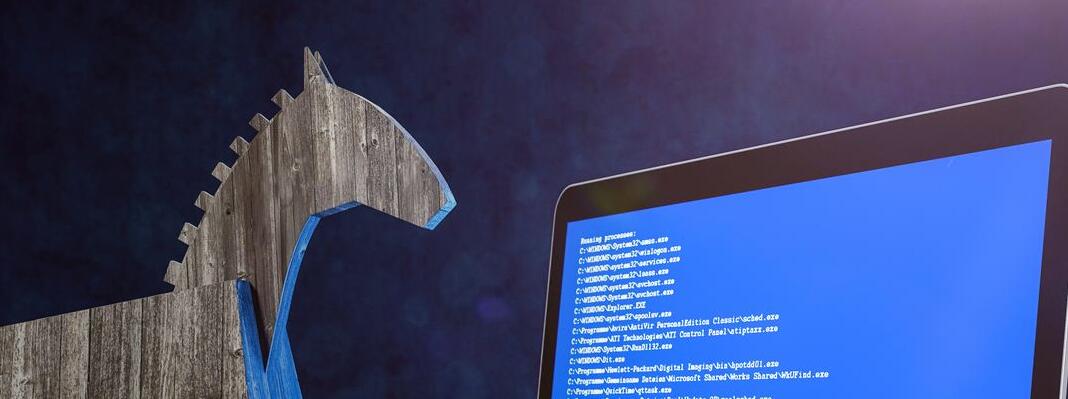The term Trojan – also known as the Trojan horse – describes a harmful computer program. This makes it seem like a trustworthy application. In fact, however, hackers and cyber criminals smuggle this type of software into third-party computers in order to, for example, spy on confidential data or gain access to the system. You can protect your computer from Trojans with anti-malware software.
- A Trojan horse is malicious software that disguises itself as a useful application.
- Hackers use Trojans, among other things, to gain access to a PC, steal data or take over the computer completely.
- Special Trojan scanners and anti-virus programs are protective measures against Trojans.
Trojans – neither virus nor worm
Many users also use the term “Trojans” as a synonym for viruses and worms. However, these are considered a separate class of malware . Basically, Trojans as well as viruses and worms fall into the category of malicious computer programs (“Malicious Software”, ” malware ” for short ). What they have in common is the potential damage they can do to a computer. However, each malware variant has its own characteristics.
The biggest difference to computer viruses and worms is that a Trojan does not reproduce itself. Instead, it carries other programs such as viruses or adware with it and infiltrates them undetected onto the computer.
Types of Trojans
The name “Trojan” is derived from the Trojan horse used by the Greeks in Homer’s story to deceive the defenders of the city of Troy. Similarly, the Trojan contains a malicious program in a file that appears harmless at first glance. There are now a large number of Trojans that fulfill various functions. The most common types include:
- Backdoor Trojans – give an attacker access to a computer
- Downloader Trojans – are used to download additional content to the infected PC
- Infostealer Trojans – aimed at stealing data
- DDoS Trojans – use infected computers to flood a network with requests and thereby shut it down
- Remote Access Trojans – put computers under complete control of the attacker
How does a Trojan get onto a computer?
A data transfer is necessary for a Trojan to get onto a computer. As a result, downloads – of e-mail attachments , for example – are the main sources of malware infection. If you simply visit a website, however, there is no risk of infecting your PC with a Trojan. Another way of spreading the malware is by someone who has already been harmed: As long as they have not recognized the Trojan attack on their computer, they can still consider the software responsible for it to be harmless – and recommend or pass it on to other users. They then unwittingly but actively download the malware onto their PCs themselves.
How can you tell if a system is infected with a Trojan horse?
If a Trojan horse is on the computer, different symptoms will appear depending on the type of malware. The warning signals include:
- Sudden shutdown or shutdown of Windows during normal operation
- inexplicable crashes of the operating system
- Taskbar suddenly no longer visible
- swapped mouse buttons
- DVD drive opens and closes by itself
- Task Manager shows suspicious processes
- Websites open in the browser without any action on your part
- turned off virus scanner
- Windows update is no longer possible
Protect the system with a Trojan horse scanner
With the latest anti-malware software, users can protect their computers from malware such as Trojans, viruses and worms. However, you can also find specialized Trojan scanners online.
Reliable software not only detects attacks by a Trojan, it also blocks and removes it at the same time. Since more and more hackers are focusing on smartphones and tablets , users should also secure their mobile devices accordingly.
Remove Trojans – How It Works
There are several ways to remove a Trojan. The easiest way to do this is with anti-malware software. To do this, perform a scan with the program. Then remove all finds. In the case of a new Trojan horse, however, it can happen that it is not yet in the database of the corresponding tool and the scanner therefore does not recognize the malicious program.
If the Trojan horse scanner does not find the intruder, restart your computer in Safe Mode and scan again. Since Windows only loads the most necessary services in this case, the Trojan usually remains deactivated. This enables it to be removed in many cases. If this step does not help either, it is advisable to perform a system restore. To do this, select a point in time at which the malware had not yet infected the system. The radical solution is to reinstall the operating system.
Free download trojan remover
Many users wonder whether reliable anti-malware software or a Trojan horse scanner or remover inevitably costs money. The welcome answer is no. Numerous providers of the corresponding software make these available for download free of charge. In many cases, the developers also offer premium versions for a fee that have additional functions, such as protection against security gaps or automatic driver updates.
Keep the system free from Trojans – with these tips
A Trojan horse scanner provides good basic protection, but you shouldn’t rely on it alone. The following tips can further reduce the risk of malware infestation:
- Keep software and operating system up to date, install security updates immediately
- have scans carried out automatically at regular intervals
- not visit unsafe websites
- do not open attachments from unknown sources
- Protect user accounts with complex passwords
- Use firewall

